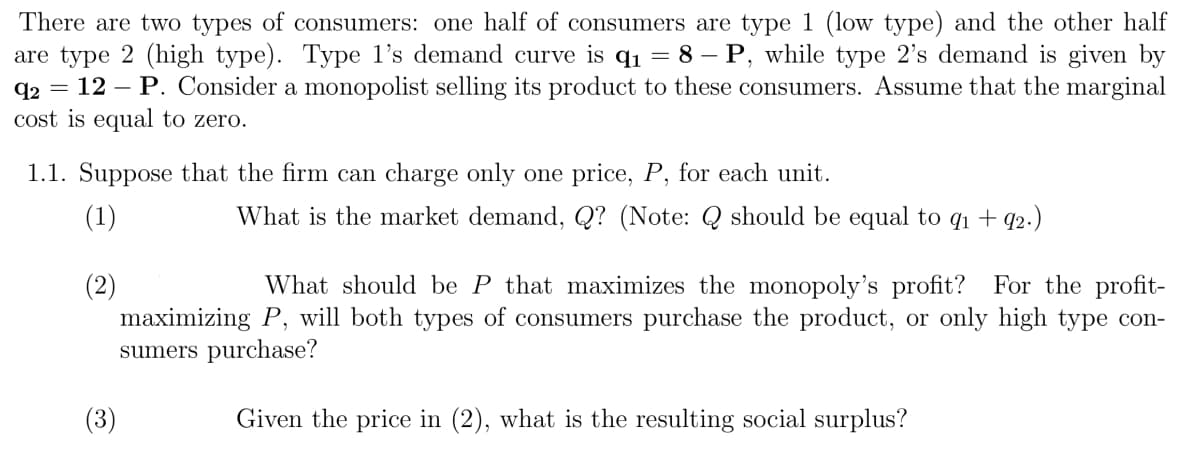There are two types of consumers: one half of consumers are type 1 (low type) and the other half are type 2 (high type). Type l's demand curve is q1 = 8 – P, while type 2's demand is given by 12 – P. Consider a monopolist selling its product to these consumers. Assume that the marginal q2 || cost is equal to zero. 1.1. Suppose that the firm can charge only one price, P, for each unit. (1) What is the market demand, Q? (Note: Q should be equal to q1 + q2.) What should be P that maximizes the monopoly's profit? For the profit- (2) maximizing P, will both types of consumers purchase the product, or only high type con- sumers purchase? (3) Given the price in (2) what is the resulting social surplus?
There are two types of consumers: one half of consumers are type 1 (low type) and the other half are type 2 (high type). Type l's demand curve is q1 = 8 – P, while type 2's demand is given by 12 – P. Consider a monopolist selling its product to these consumers. Assume that the marginal q2 || cost is equal to zero. 1.1. Suppose that the firm can charge only one price, P, for each unit. (1) What is the market demand, Q? (Note: Q should be equal to q1 + q2.) What should be P that maximizes the monopoly's profit? For the profit- (2) maximizing P, will both types of consumers purchase the product, or only high type con- sumers purchase? (3) Given the price in (2) what is the resulting social surplus?
Micro Economics For Today
10th Edition
ISBN:9781337613064
Author:Tucker, Irvin B.
Publisher:Tucker, Irvin B.
Chapter13: Antitrust And Regulation
Section: Chapter Questions
Problem 10SQP
Related questions
Question

Transcribed Image Text:There are two types of consumers: one half of consumers are type 1 (low type) and the other half
are type 2 (high type). Type l's demand curve is q1 = 8 – P, while type 2's demand is given by
q2 = 12 – P. Consider a monopolist selling its product to these consumers. Assume that the marginal
cost is equal to zero.
1.1. Suppose that the firm can charge only one price, P, for each unit.
(1)
What is the market demand, Q? (Note: Q should be equal to q1 + q2.)
What should be P that maximizes the monopoly's profit? For the profit-
(2)
maximizing P, will both types of consumers purchase the product, or only high type con-
sumers purchase?
(3)
Given the price in (2), what is the resulting social surplus?
Expert Solution
This question has been solved!
Explore an expertly crafted, step-by-step solution for a thorough understanding of key concepts.
This is a popular solution!
Trending now
This is a popular solution!
Step by step
Solved in 6 steps with 1 images

Recommended textbooks for you








Exploring Economics
Economics
ISBN:
9781544336329
Author:
Robert L. Sexton
Publisher:
SAGE Publications, Inc
